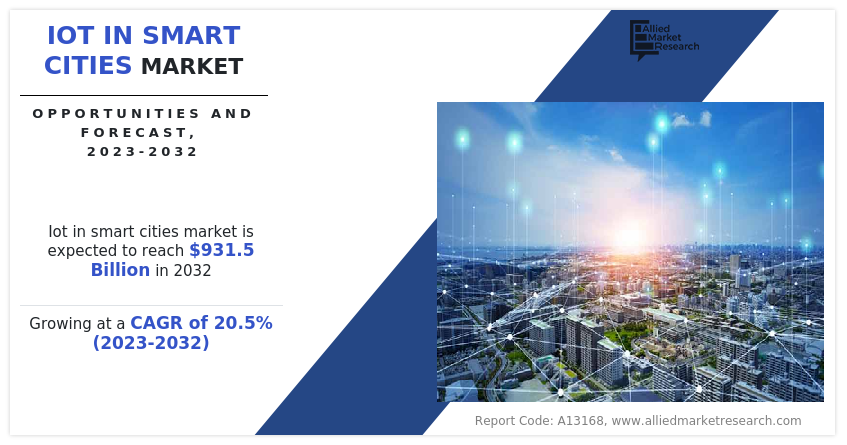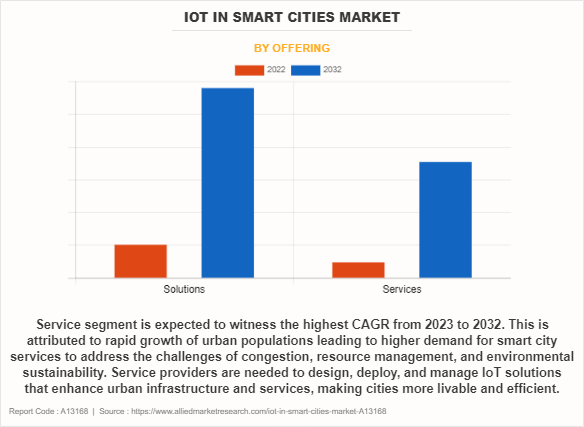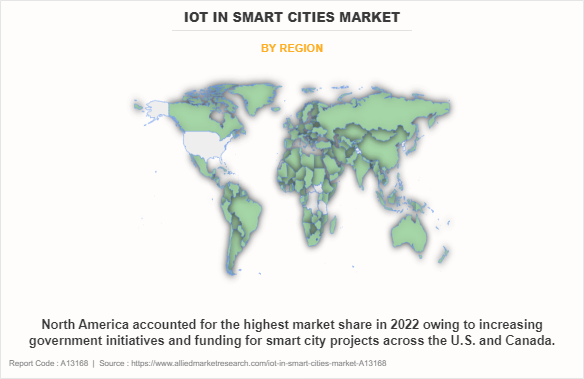IoT in Smart Cities Market Insight, 2032
The global IoT in smart cities market was valued at USD 148.6 billion in 2022, and is projected to reach USD 931.5 billion by 2032, growing at a CAGR of 20.5% from 2023 to 2032.
The Internet of Things (IoT) in smart cities uses smart technologies and connected devices to collect real-time information about the external environment throughout the city. The concept of smart cities combines IoT devices, sensors and data analytics to improve urban growth, efficiency and sustainability areas. The increasing government initiatives and smart city projects is a key driver for the growth of the IoT in smart cities market. The rapid growth of IoT and smart city initiatives is increasing the demand for smart security systems, such as PIDS (Perimeter Intrusion Detection System).

In addition, there is a strong emphasis on effective energy management technologies to ensure accurate metering and reduce waste. IoT technology suppliers are being invited to contribute to smart city transportation infrastructure to enable adequate monitoring and management, reduce carbon emissions, and provide better route planning and optimization. Furthermore, growth in deployment of connected and smart technologies is a key market driver. However, high initial investment while implementing IoT systems is a major factor hampering the IoT in smart cities market growth. Implementing an IoT system requires significant capital expenditures, including the installation of sensors, communication networks, data centers, and software systems. The cost of deploying this system can be prohibitive for budget-constrained municipalities, especially in developing regions.
Contrarily, with the development of 5G and 6G, the demand for NTN is increasing, which is a great opportunity for the IoT in smart cities industry. 5G technology offers ultra-low latency, ultra-high speeds, and connects a massive number of smart devices. The technology is capable of boosting the operational efficiency of IoT and smart city solutions. It offers high capacity and fast connection, thereby providing real-time support to the smart city solutions to analyze the behavior of citizens, infrastructure, and connected devices.
The report focuses on growth prospects, restraints, and trends of the IoT in smart cities market analysis. The study provides Porter’s five forces analysis to understand the impact of various factors, such as bargaining power of suppliers, competitive intensity of competitors, threat of new entrants, threat of substitutes, and bargaining power of buyers, on the IoT in smart cities market.
Segment Overview
The IoT in smart cities market is segmented on the basis of offering, application, and region. On the basis of offering, it is categorized into solution, and service. By application, it is divided into smart transportation, smart building, smart utilities, and smart citizen services. On the basis of region, it is analyzed across North America, Europe, Asia-Pacific, and LAMEA.

On the basis of offering, the service segment is expected to exhibit the highest CAGR for IoT in smart cities market size in 2022. This is attributed to rapid growth of urban populations is leading to higher demand for smart city services to address the challenges of congestion, resource management, and environmental sustainability.

On the basis of region, North America held the highest IoT in smart cities market share in 2022. This is attributed to the fact that network operators in this region are consistently investing in expanding and upgrading their telecom networks, as well as transitioning to 5G infrastructure using technologies like cloud edge computing and network slicing, accelerating the adoption of IoT in smart cities for low-cost, strategic urban management.
The report analyzes the profiles of key players operating in the IoT in smart cities market such as Cisco Systems Inc., Siemens, Huawei Technologies Co., Ltd., Innowise Group, GE Digital, SAP SE, Altoros, Bosch Limited, PTC, and Andersen Inc. These players have adopted various strategies to increase their market penetration and strengthen their position in the IoT in smart cities industry.
Market Landscape and Trends
Continuous advancements in loT technology, sensors, connectivity, and data analytics are expanding the possibilities for smart city applications. As technology continues to evolve, more sophisticated and efficient solutions will emerge, driving market growth and innovation. In addition, urban areas are undergoing significant transformations, with increased emphasis on sustainability, resilience, and citizen-centric development. This shift in urban priorities creates a favorable environment for the adoption of loT solutions in smart cities.
Moreover, edge computing is gaining prominence in smart cities. By processing data closer to the source (IoT devices), edge computing reduces latency and bandwidth usage. This trend enables faster decision-making and supports applications like autonomous vehicles and real-time public safety systems. Furthermore, governments are enacting policies and regulations to govern the deployment of loT in smart cities, addressing concerns such as data privacy, security, and ethical use of technology. A clear and supportive regulatory framework can foster market growth and encourage investments in smart city projects.
Top Impacting Factors
Growth in Deployment of Connected and Smart Technologies
Internet of Things (IoT), cloud, mobility, data connectivity, and AI, contribute to the design of smart cities. In recent years, the rise of this technology has enabled greater connectivity, completely reinventing the smart city ecosystem. Also, there is interest in various growth technologies, with machine learning, data analytics, IoT, and cybersecurity set to have a major impact on smart city projects in the next few years. In addition, as connected technologies proliferate across industries such as transportation, utilities, and public services, they provide a wealth of information.
The IoT technology acts as the glue that connects these disparate sources of data, enabling cities to develop a holistic approach to urban operations. This integration is essential for optimal resource management, optimal traffic management and optimal service delivery. Furthermore, the expansion of IoT in smart cities will create opportunities for businesses in areas such as IoT device development, data analytics, and software development. As cities invest in IoT infrastructure, they attract investments that invest and stimulate economic development in their communities. Therefore, these trends are driving the growth of the IoT in smart cities market.
Increase in Government Initiatives and Smart City Projects
The rapid growth of IoT and smart city initiatives is increasing the demand for smart security systems, such as PIDS (Perimeter Intrusion Detection System). In addition, there is a strong emphasis on effective energy management technologies to ensure accurate metering and reduce waste. IoT technology suppliers are being invited to contribute to smart city transportation infrastructure to enable adequate monitoring and management, reduce carbon emissions, and provide better route planning and optimization. Moreover, with the growing urbanization, the metro and tier-one cities are witnessing vast population and revenue growth. Also, the demand for energy-efficient technological solutions in metropolitan cities is increasing. Digital technology has huge potential in dealing with these increasing challenges in the cities.
For this, governments across the globe are focusing on implementing smart city projects. Smart solutions can be used to address real-time situations in the city, which will reduce its impact on other resources. For instance, in March 2020, the Seoul Metropolitan Government, in partnership with the World Bank, hosted Korea Innovation Week to represent Korea’s development across technologies. Twelve countries' 40 government officials learned about the smart city development and transformation in the city. The government has focused extensively on areas, such as waste management, e-governance, and smart energy solutions, through smart city innovation.
Sustainability and Resource Optimization
Growing concerns about climate change and environmental degradation are pushing cities to embrace sustainable practices. IoT plays an important role in monitoring and controlling environmental factors such as air quality, water quality and energy consumption. Real-time data from IoT sensors enable cities to make informed decisions to reduce their environmental footprint. In addition, IoT technologies are essential for optimizing energy use in smart cities. Smart grids, for instance, leverage IoT to monitor and control energy distribution efficiently. IoT sensors in buildings can adjust heating, cooling, and lighting based on occupancy and environmental conditions, leading to significant energy savings.
Furthermore, IoT-powered transportation solutions contribute to sustainability by reducing traffic congestion and emissions. Smart traffic management systems optimize traffic flow, while connected public transportation options encourage the use of eco-friendly modes of travel, such as buses and bicycles. Therefore, these trends are driving the growth of the IoT in smart cities market.
Hugh Initial Investment
Implementing an IoT system requires significant capital expenditures, including the installation of sensors, communication networks, data centers, and software systems. The cost of setting up this system can be prohibitive for budget-constrained municipalities, especially in developing regions. Moreover, sensors are the backbone of IoT in smart cities, and should be strategically placed throughout the city to collect relevant data. Purchasing and installing these sensors in various locations can be a capital-intensive process.
In addition, ensuring reliable and high-speed connectivity for IoT devices often requires investment in advanced communication networks like 5G or LoRaWAN. These networks require substantial initial expenditures for infrastructure development. Further, cities often rely on grants and funding from regional, national, or international bodies to support their IoT initiatives. The availability and accessibility of these grants can vary, impacting a city's ability to secure the necessary funds. Overall, propagation delay and low latency devices are major restraining factors for the growth of the market.
Increase in Implementation of 5G Technology
The growing implementation of 5G technology and its expanding infrastructure are offering high opportunities for various applications. The 5G technology offers ultra-low latency, ultra-high speeds, and connects a massive number of smart devices. The technology is capable of boosting the operational efficiency of IoT and smart city solutions. It offers high capacity and fast connection, thereby providing real-time support to the smart city solutions to analyze the behavior of citizens, infrastructure, and connected devices.
In addition, government and IoT technology providers across the globe are focusing on implementing 5G infrastructure. For instance, to improve the smart city infrastructure, the Government of India is focusing on developing 5G architecture for smart cities. Furthermore, 5G complements edge computing capabilities, allowing data processing and analytics to occur closer to the source of data, reducing latency and bandwidth usage. This is particularly beneficial for IoT applications that require real-time insights, such as smart traffic management and healthcare monitoring. Thus, the 5G technology can play a critical role in driving the IoT in smart cities industry.
Citizen Engagement and Co-Creation
Engaging citizens in the planning and development of IoT solutions allows cities to create tailored services and applications that address specific community needs. This approach results in more relevant and effective IoT deployments, which can lead to increased adoption and acceptance. Further, IoT enables cities to collect real-time data on various aspects of urban life, from traffic conditions to environmental quality. Citizens can actively contribute to this data by providing feedback and insights through mobile apps and online platforms. This two-way communication enhances situational awareness and enables cities to respond quickly to emerging issues.
In addition, citizen engagement empowers communities to take an active role in improving their neighborhoods. IoT applications, such as reporting potholes or reporting incidents of vandalism, allow residents to collaborate with city authorities to address local concerns. This sense of ownership and responsibility fosters a stronger sense of community. Therefore, these factors will enhance growth prospects for the industry.
Key Benefits for Stakeholders
This report provides a quantitative analysis of the market segments, current trends, estimations, and dynamics of the IoT in smart cities market forecast from 2022 to 2032 to identify the prevailing market opportunities.
Market research is offered along with information related to key drivers, restraints, and opportunities of IoT in smart cities market outlook.
Porter's five forces analysis highlights the potency of buyers and suppliers to enable stakeholders to make profit-oriented business decisions and strengthen their supplier-buyer network.
In-depth analysis of the IoT in smart cities market segmentation assists in determining the prevailing IoT in smart cities market opportunity.
Major countries in each region are mapped according to their revenue contribution to the global market.
Market player positioning facilitates benchmarking and provides a clear understanding of the present position of the market players.
The report includes an analysis of the regional as well as global IoT in smart cities market trends, key players, market segments, application areas, and market growth strategies.
IoT in Smart Cities Market Report Highlights
| Aspects | Details |
| Market Size By 2032 | USD 931.5 billion |
| Growth Rate | CAGR of 20.5% |
| Forecast period | 2022 - 2032 |
| Report Pages | 250 |
| By Offering |
|
| By Application |
|
| By Region |
|
| Key Market Players | SAP SE, Cisco Systems Inc., Bosch Limited, Innowise Group, Huawei Technologies Co., Ltd., Andersen Inc., PTC, Siemens, Altoros, GE Digital |
Analyst Review
The rollout of 5G networks is accelerating IoT adoption in smart cities. The high-speed, low-latency connectivity provided by 5G is essential for supporting a vast number of IoT devices and applications, enabling real-time data exchange and enhancing the performance of critical urban services. Moreover, smart cities are increasingly focusing on citizen-centric solutions. IoT technologies are being used to engage citizens in co-creation efforts, allowing residents to actively participate in shaping urban services, reporting issues, and providing feedback, ultimately leading to more inclusive and responsive cities. Furthermore, the growing interest of governments in developing smart spaces and resources in metropolitan cities is expected to drive market growth. Smart city solutions are expected to boost the quality of living along with energy-saving solutions. In addition, the availability of real-time data from IoT devices enables data- driven decision-making in various areas such as traffic management, energy optimization, and public safety. The increasing emphasis on data analytics and predictive modeling will further drive the demand for loT solutions in smart cities.
The market players are adopting strategies such as partnership for enhancing their services in the market and improving customer satisfaction. For instance, in October 2020, Microsoft partnered with Bentley Systems, an American-based software development company that develops, manufactures, licenses, sells, and supports computer software and services for the design, construction, and operation of infrastructure. Under this partnership, Azure IoT Digital Twins of Microsoft would be integrated with the iTwins platform, enabling engineers, architects, constructors, and city planners of Bentley Systems to work within an exhaustive city-scale digital twin, enabling better decision-making, driving up operation efficiency, decreasing costs, and enhancing collaboration. Therefore, such strategies are expected to boost the growth of the IoT in smart cities market in the upcoming years.
Moreover, some of the key players profiled in the report are Cisco Systems Inc., Siemens, Huawei Technologies Co., Ltd., Innowise Group, GE Digital, SAP SE, Altoros, Bosch Limited, PTC, and Andersen Inc. These players have adopted various strategies to increase their market penetration and strengthen their position in the industry.
The IoT in smart cities market is estimated to grow at a CAGR of 20.5% from 2023 to 2032.
The IoT in smart cities market is projected to reach $931.5 billion by 2032.
Growth in deployment of connected and smart technologies, increase in government initiatives and smart city projects, and sustainability and resource optimization majorly contribute toward the growth of the market.
The key players profiled in the report include IoT in smart cities market analysis includes top companies operating in the market such as Cisco Systems Inc., Siemens, Huawei Technologies Co., Ltd., Innowise Group, GE Digital, SAP SE, Altoros, Bosch Limited, PTC, and Andersen Inc.
The key growth strategies of IoT in smart cities players include product portfolio expansion, mergers & acquisitions, agreements, geographical expansion, and collaborations.
Loading Table Of Content...
Loading Research Methodology...



